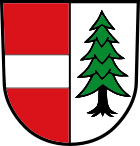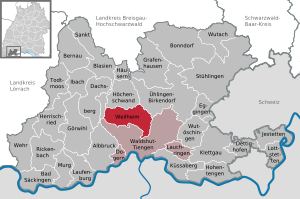Weilheim (Baden)
| coat of arms | Germany map | |
|---|---|---|

|
Coordinates: 47 ° 39 ' N , 8 ° 14' E |
|
| Basic data | ||
| State : | Baden-Württemberg | |
| Administrative region : | Freiburg | |
| County : | Waldshut | |
| Height : | 517 m above sea level NHN | |
| Area : | 35.64 km 2 | |
| Residents: | 3146 (Dec. 31, 2018) | |
| Population density : | 88 inhabitants per km 2 | |
| Postal code : | 79809 | |
| Primaries : | 07741, 07755, 07747 | |
| License plate : | WT | |
| Community key : | 08 3 37 118 | |
| Address of the municipal administration: |
Badener Platz 1 79809 Weilheim |
|
| Website : | ||
| Mayor : | Jan Albicker | |
| Location of the community of Weilheim in the district of Waldshut | ||
Weilheim is a municipality in the Waldshut district in Baden-Württemberg .
geography
location
Weilheim is located in southern Baden-Württemberg on the southern edge of the Hotzenwald . The municipality borders in the south on the district town of Waldshut-Tiengen . The Upper Rhine , which forms the border with Switzerland, flows here.
Other neighboring communities are Albbruck , Höchenschwand and Ühlingen-Birkendorf .
Community structure
The former communities of Bannholz, Bierbronnen, Nöggenschwiel and Remetschwiel belong to the community of Weilheim.
The former community of Bannholz includes the village of Bannholz, the hamlets Aisperg and Ay, the Zinken Except Ay and the farmstead Auf dem Hof. The villages of Bierbronnen (Ober and Unter) and Rohr, the hamlet Heubach and the homestead Löchlemühle belong to the former municipality of Bierbronnen. The village of Nöggenschwiel and the house Fohrenbach (er) Mühle belong to the former municipality of Nöggenschwiel, the villages of Remetschwiel and Brunnadern and the residential area of Waldhaus belong to the former municipality of Remetschwiel. The villages of Weilheim, Bürglen and Dietlingen and the hamlet of Schnörringen belong to the community of Weilheim within the boundaries of 1974.
The Wislangen desert lies in the area of the former municipality of Bierbronnen . In the area of the former municipality, there are two castles that were mentioned in 1279 and that were abandoned, as well as the Oberwihl desert. The town of Haselbach, first mentioned in 1276, was absorbed by the villages of Weilheim and Indlekofen , and the castles Gutkrenkingen and Isnegg, which were abandoned in 1974, are in the area of the community of Weilheim .
The remains of Gut-Krenkingen Castle , a tower hill castle from the 12th century, are located near the community of Weilheim . Leinegg Castle is located north of the Nöggenschwiel district .
history
As prehistoric and early historical finds attest ( Menhir von Nöggenschwiel ), Weilheim is an ancient settlement area.
“A burial mound in the Gewann Dörnen [near Nöggenschwiel] and a bronze dagger prove that this high altitude area was already inhabited during the Bronze Age (2000 to 1000 BC). From the time of Roman rule (1st to 4th century AD), the remains of the building, pointing to a Roman watchtower, which stood in the south-east on the height in front of the village, probably come from. The Burgegge, mentioned in a document from 1279, was at this height with a wide panoramic view. ” There is another menhir to the southwest of the village of Nöggenschwiel .
Aisperg was first mentioned in a document in 890, while Weilheim itself was first mentioned in 929 as Wilhaim . The district of Bannholz , attested in a document from the Rheinau monastery in 871 , which was the seat of the bailiwick in the Middle Ages , is even older . The Alpine chain can be seen from the 780 meter high Gupfen . The village of Weilheim-Remetschwiel is said to have been even older and built on the foundations of a Roman settlement.
Until the last century, large areas of wine were grown around Weilheim. The viticulture that is discontinued today goes back well into the Middle Ages. In 1351 the monks of St. Blasien owned four vineyards in Weilheim alone. In 1383 a monastery courtyard in Nöggenschwiel is mentioned, which also included an extensive vineyard.
Today, however, the rose is the focus of the community. Since 1970 the district Nöggenschwiel, first mentioned in 1279 as villa Noecherswiler , with its more than 20,000 rose bushes has held the title “Rosendorf in the Black Forest” and in 1965 won the nationwide competition Our village should become more beautiful . This led to a boom in tourism.
In the 18th century there was a wave of emigration to Hungary , in the 19th century to the USA .
The current community was formed on January 1, 1975 by the union of the communities Weilheim, Bannholz, Bierbronnen, Nöggenschwiel and Remetschwiel.
 Spellwood |
 Beer fountains |
 Nöggenschwiel |
 Callosity |
 Weilheim (old) |
|---|
politics
Municipal council
The community council in Weilheim has 12 members. It consists of the elected honorary councilors and the mayor as chairman. The mayor is entitled to vote in the municipal council. The local elections on May 26, 2019 led to the following final result.
| Political party | be right | Seats | 2014 result |
| Joint List (GL) | 41.3% | 5 | 41.4%, 5 seats |
| CDU | 33.7% | 4th | 34.4%, 4 seats |
| List of Independent Citizens (LUB) | 25.1% | 3 | 24.3%, 3 seats |
Partnerships
Weilheim has had a community partnership with the French community of Baden (Morbihan) in Brittany since 1992 .
economy
The Waldhaus private brewery is located in the Waldhaus district and the international company Holzbau Amann GmbH is in Bannholz .
Attractions
With its location on the undulating plateau of the Hotzenwald , which is sloping towards the Upper Rhine in the south, Weilheim benefits on the one hand from the Alpine panorama and on the other hand from the contrasting landscape with the great gorges of the Schwarza and the Schlucht .
The upper waterfall of the Haselbach east of Indlekofen (see also the list of waterfalls in Germany ) plunges twelve meters deep into an almost circular rock basin at the bottom of a small gorge with a compact jet. (Not to be confused with the hazel basin )
With the lower waterfall , the Haselbach falls through a short gorge-like gap nine meters deep into the Teufelskessel just before it flows into the Schlucht .
The Hohfluhfelsen east of Nöggenschwiel offers a barrier-free, deep view of the Schwarzatal with the forest of the Berauer Halde (municipality of Ühlingen-Birkendorf ) and the Witznau reservoir up to the Schlüchttal.
With construction work at a brewery, which took place from 1988 to 1990 at Waldhaus, were in there pending the layers Upper Bunter ( early Middle Triassic ) discovered several bones, which for the purpose of scientific treatment in the State Museum of Natural History in Stuttgart were spent. The remains found include various types of fish as well as a reptile specimen, which was initially thought to be a young of the species Tanystropheus antiquus . Later investigations showed, however, that this piece can only be classified as an indeterminable member of the Tanystropheidae family due to poor conservation. Furthermore, bones of a purely rural ancestor of today's crocodiles, a so-called "Rauisuchier", came to light. They are very similar to those of the "Rauisuchiers" Ctenosauriscus koeneni . The latter is used as the producer of a special, large variant of the Ichnospezies Chirotherium sickleri , as they are e.g. B. was found in Hardheim , suspected.
Sports
Circular paths and cycle paths connect the individual districts.
education
The Gustav Siewerth Academy in the Bierbronnen district has been a privately owned, state-recognized academic university since 1988 . In June 2013 the university was withdrawn from state recognition by the Baden-Württemberg Minister of Science , Theresia Bauer , because it was unable to maintain a sustainable university structure with its part-time academic staff, for which 12,000 to 26,000 euros were spent annually. It was founded by Alma von Stockhausen , who is still the dean of the academy today. The academy teaches philosophy , sociology , journalism , philosophy of natural sciences , Catholic theology and education .
Personalities
- Konstantin Karl Falkenstein (1801–1855), historian, librarian and writer, was born in the Forsthaus Wohlfahrtsmatt in the district of Remetschwiel.
- August Pfeifer SJ (born October 29, 1877 in the hamlet of Ay (district Bannholz), † May 28, 1919), priest, theologian and philosopher
- Helen Grobert (* 1992), mountain bike athlete, grew up in Remetschwiel
literature
- Hubert Matt-Willmatt, " Weilheim im Landkreis Waldshut ", community Weilheim 1977
Individual evidence
- ↑ State Statistical Office Baden-Württemberg - Population by nationality and gender on December 31, 2018 (CSV file) ( help on this ).
- ^ The state of Baden-Württemberg. Official description by district and municipality. Volume VI: Freiburg region Kohlhammer, Stuttgart 1982, ISBN 3-17-007174-2 . Pp. 1039-1043
- ^ Hans Matt-Willmatt: Chronik , 1957, Nöggenschwiel , p. 66.
- ↑ StiASG , Urk. IV 400. Online at e-chartae , accessed on June 12, 2020.
- ^ Federal Statistical Office (ed.): Historical municipality directory for the Federal Republic of Germany. Name, border and key number changes in municipalities, counties and administrative districts from May 27, 1970 to December 31, 1982 . W. Kohlhammer, Stuttgart / Mainz 1983, ISBN 3-17-003263-1 , p. 523 .
- ^ Result of the 2019 municipal council elections at the State Statistical Office
- ↑ Holzbau Amann GmbH. Retrieved April 3, 2019 .
- ^ Franz Falkenstein, Saurier bei Waldhaus - About the oldest fossils in the district , in: Heimat am Hochrhein Volume XVI., 1991, pp. 70 ff. ISBN 3-87799-097-5
- ↑ a b Klaus Ebel, Franz Falkenstein, Frank-Otto Haderer, Rupert Wild: Ctenosauriscus koeneni (v. Huene) and the Rauisuchier von Waldshut - Biomechanical interpretation of the spine and relations to Chirotherium sickleri Kaup. Stuttgart Contributions to Natural History, Series B., No. 261, 1998, online
- ^ Nicholas C. Fraser, Olivier Rieppel: A new protorosaur (Diapsida) from the Upper Buntsandstein of the Black Forest, Germany. Journal of Vertebrate Paleontology. Vol. 26, No. 4, 2006, pp. 866-871, doi : 10.1671 / 0272-4634 (2006) 26 [866: ANPDFT] 2.0.CO; 2
- ^ "Academy without recognition" Badische Zeitung, July 1, 2013
- ↑ biography





